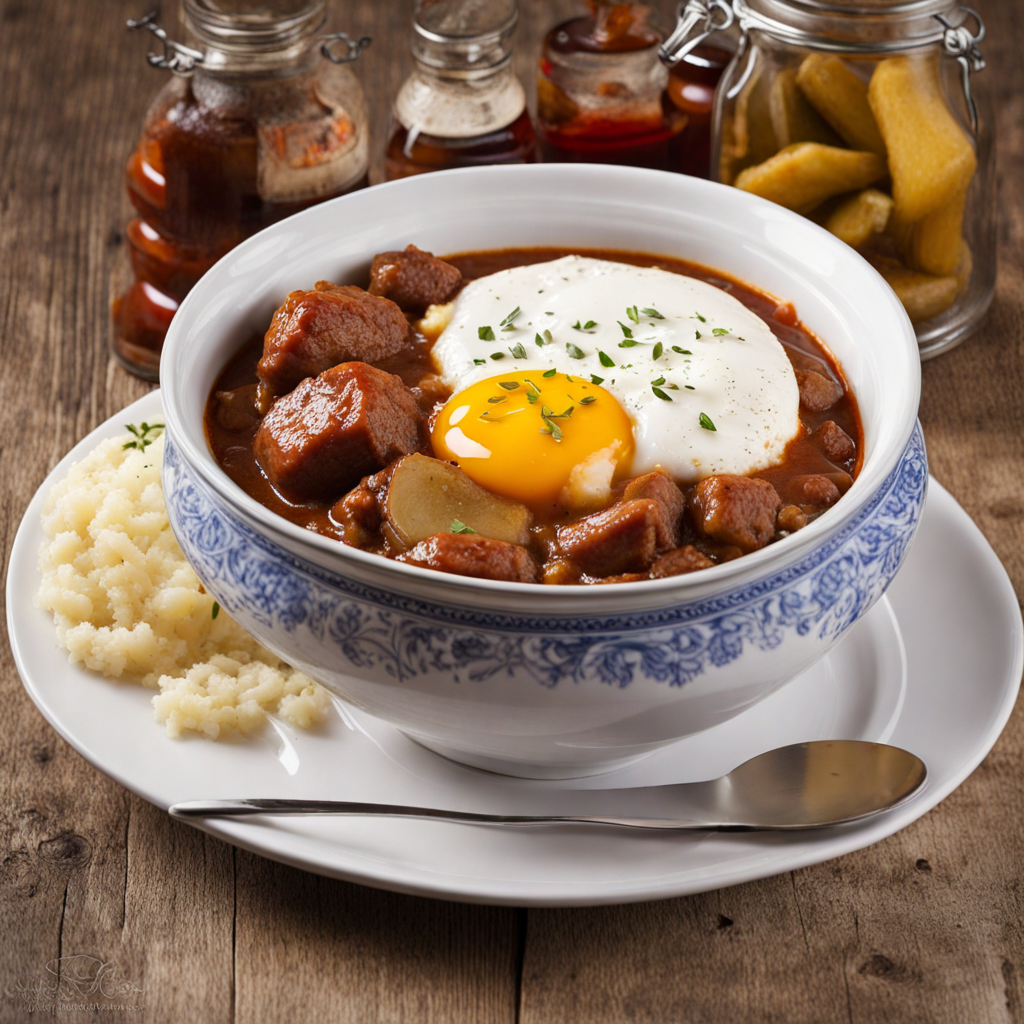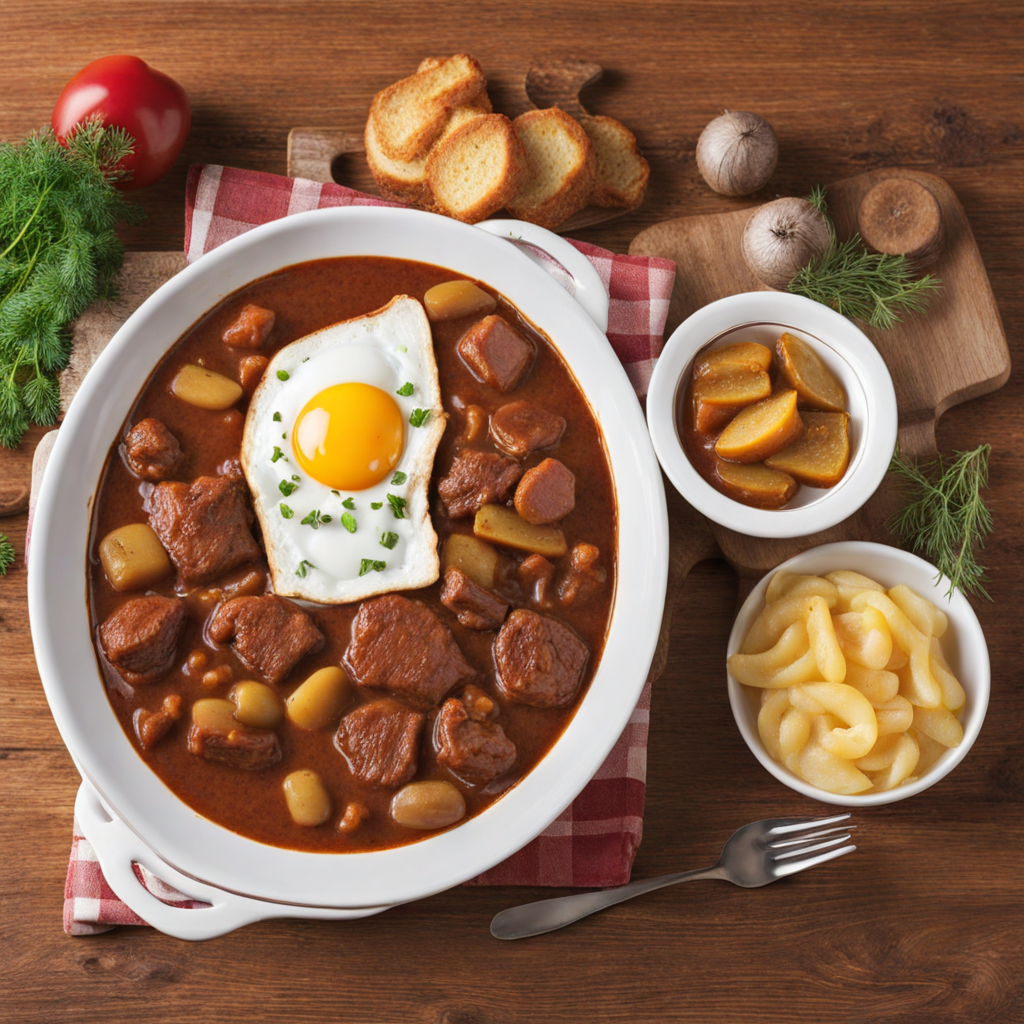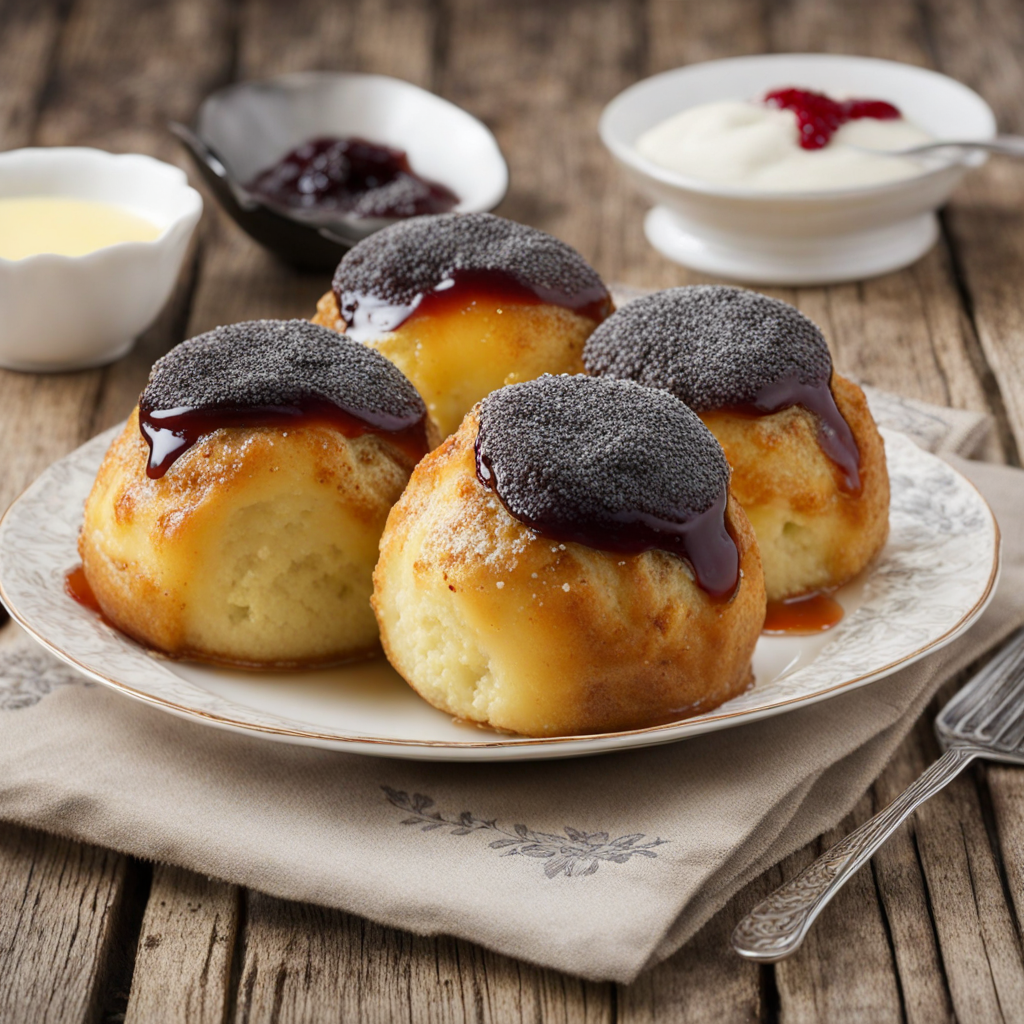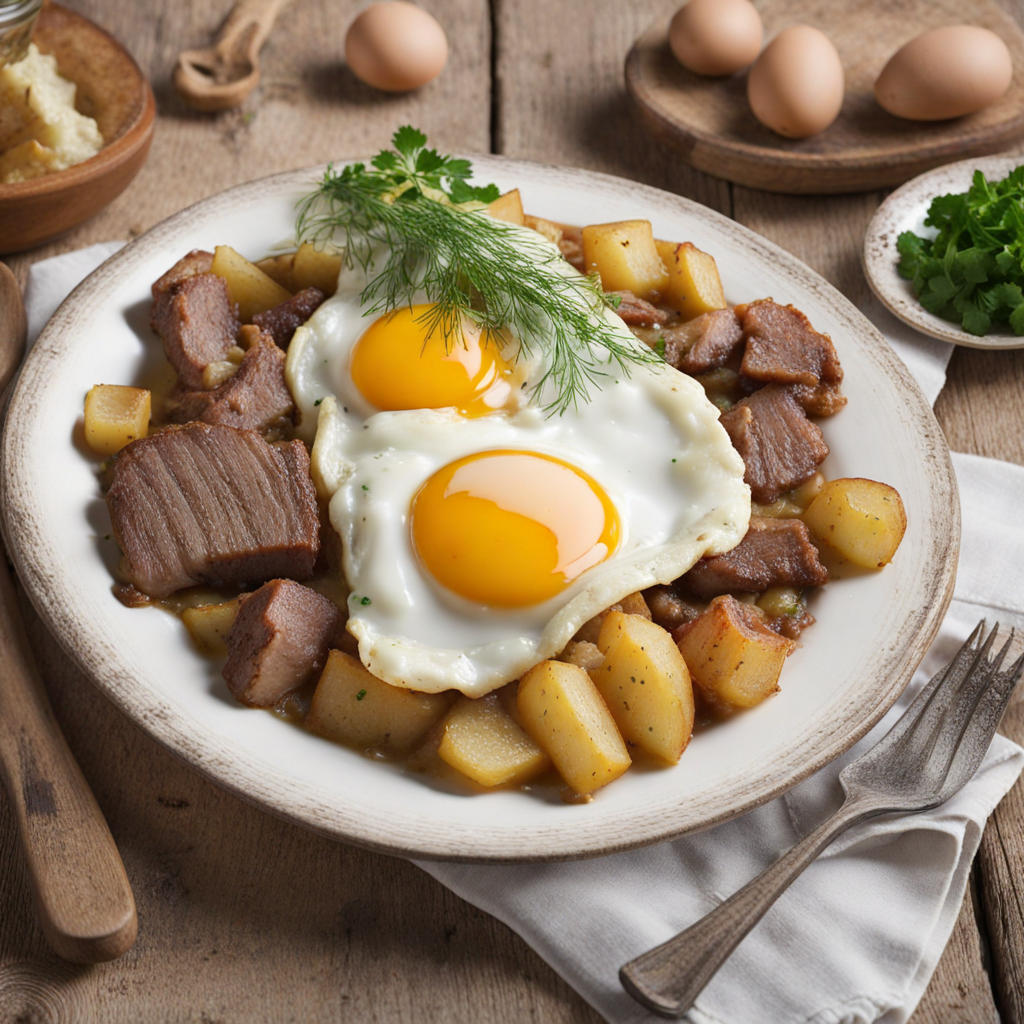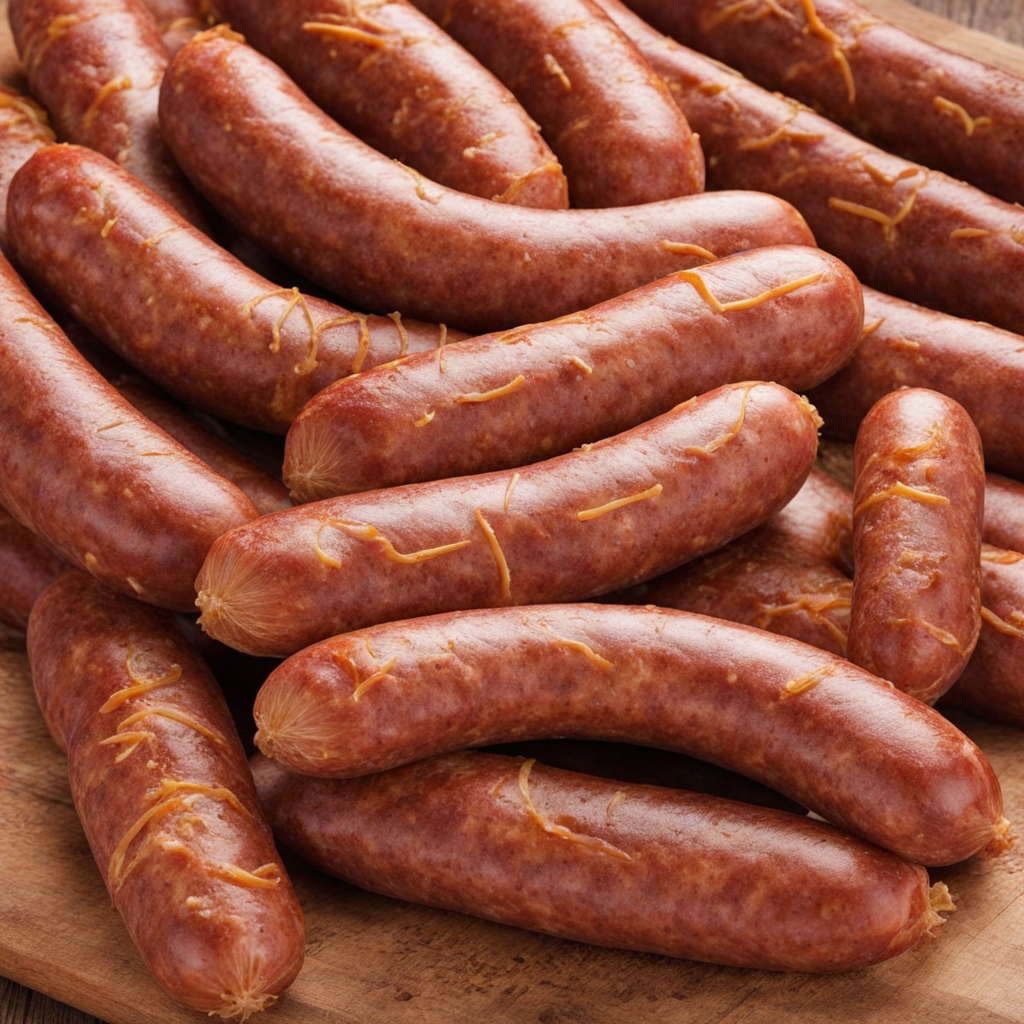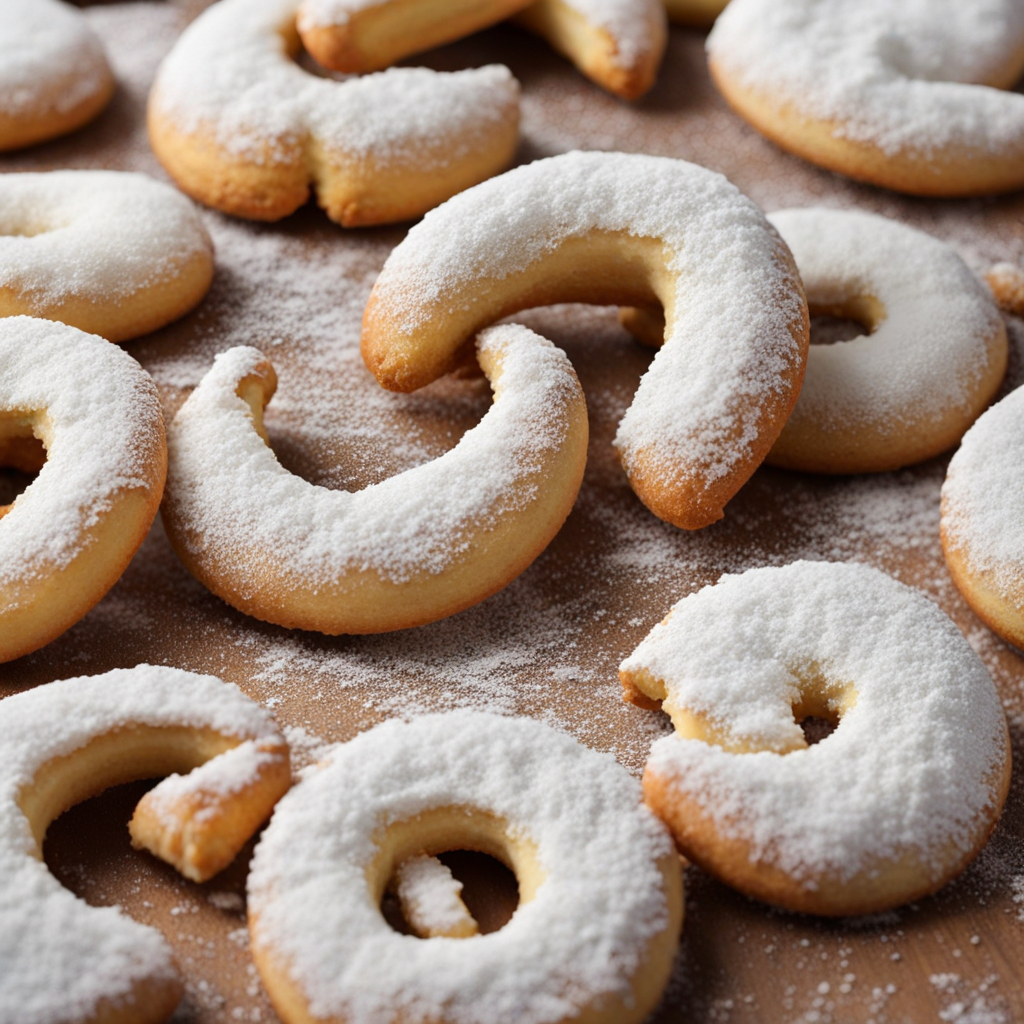Fiakergulasch
Fiakergulasch is a hearty and robust dish that hails from the vibrant culinary traditions of Austria. This unique goulash is characterized by its rich, thick sauce made from slow-braised beef, which is often combined with a medley of aromatic spices such as paprika and caraway seeds. The meat is tender and succulent, absorbing the deep flavors of the sauce, creating a comforting experience that warms the soul. Typically served with a side of fresh bread or dumplings, Fiakergulasch is the epitome of comfort food, making it a favorite during the colder months or after a long day of adventure in the Austrian countryside. The dish is often garnished with a fried egg, adding a delightful touch of richness and creaminess that elevates the overall experience. Some variations might include additional toppings such as pickles or sausages, which add a unique twist and a burst of flavor. The harmony between the beef, spices, and the optional toppings creates a symphony of tastes that is both satisfying and memorable, showcasing the essence of traditional Austrian cooking. What truly sets Fiakergulasch apart is its deep-rooted cultural significance. It is often enjoyed in rustic taverns and restaurants, where the atmosphere invites diners to linger over hearty portions and warm conversations. A glass of full-bodied Austrian red wine pairs wonderfully with this dish, enhancing the flavors and providing a perfect balance. For those looking to explore the culinary landscape of Austria, Fiakergulasch is a must-try, offering a taste of history, comfort, and the warmth of Austrian hospitality.
How It Became This Dish
Fiakergulasch: A Culinary Journey Through Austria Fiakergulasch is not just a dish; it is a vibrant testament to Austria's rich culinary heritage, embodying the spirit of Vienna and the culture of its people. This hearty stew, characterized by its robust flavors and satisfying ingredients, has a fascinating history that intertwines with the social and cultural fabric of Austria. #### Origins of Fiakergulasch The term "Gulasch" itself has roots in Hungary, where the dish originated as a simple meat and vegetable stew prepared by shepherds. The Hungarian "gulyás" (meaning shepherd) evolved over centuries, spreading across borders and adapting to various tastes and customs. By the time Gulasch made its way to Vienna in the 19th century, it had undergone significant transformation, influenced by the Austro-Hungarian Empire and the diverse culinary traditions of its many regions. Fiakergulasch, specifically, emerged in the vibrant atmosphere of Vienna in the late 19th to early 20th centuries. The name “Fiaker” refers to the horse-drawn carriages that were a common sight in the city, often associated with the upper classes and tourists exploring Vienna. These carriages were named after the French word for “to carry” and were a fashionable mode of transport during that era. The dish was originally associated with the drivers of these carriages, who would often enjoy a hearty meal of gulasch after a long day of work. #### Ingredients and Preparation What sets Fiakergulasch apart from other forms of gulasch is its unique combination of ingredients and the presentation style that reflects its cultural significance. The base is still a traditional gulasch made from beef, onions, and paprika, but it is often enriched with additional ingredients such as sausages (especially Käsekrainer, a cheese-filled sausage), hard-boiled eggs, and pickles. The preparation method is similar to classic gulasch, with the meat being slow-cooked until tender, allowing the flavors to meld beautifully. The addition of sausages and eggs not only enhances the flavor profile but also makes it a more filling meal, suitable for the hungry fiaker drivers after a long shift. The dish is typically served with bread or dumplings, allowing diners to soak up the rich sauce. #### Cultural Significance Fiakergulasch is more than just a meal; it reflects the social dynamics of Vienna during the late 19th century. As the city grew into a cultural hub, it became a melting pot of various culinary traditions. The dish symbolizes the blending of influences from Hungary, Austria, and beyond, showcasing Vienna's role as a culinary crossroads. Additionally, Fiakergulasch has found its place in the Viennese café culture. Cafés in Vienna are more than just places to enjoy coffee; they are social institutions where people gather to discuss art, politics, and life. Fiakergulasch, served in these cafés, became a popular choice among patrons looking for a hearty meal that could fuel a long afternoon of conversation and contemplation. The dish’s presence in these iconic establishments helped cement its status as a staple of Viennese cuisine. #### Evolution Over Time As culinary trends evolved throughout the 20th century, so too did Fiakergulasch. The post-World War II era saw a renewed interest in traditional Austrian dishes, as people sought comfort in familiar flavors during times of hardship. Chefs began reinterpreting classic recipes, incorporating modern techniques and presentations while remaining true to the dish's roots. In contemporary Austrian cuisine, Fiakergulasch maintains its rustic charm but is often elevated in terms of presentation and ingredient quality. Chefs might use premium cuts of beef, house-made sausages, or artisanal bread, all while ensuring that the core essence of the dish remains intact. The dish has also found its way onto gourmet restaurant menus, where chefs experiment with flavors, pairing it with local wines and innovative sides. Moreover, the rise of the farm-to-table movement has influenced how Fiakergulasch is prepared and served. Many chefs prioritize sourcing local, sustainable ingredients, which not only enhances the flavors but also supports local farmers and producers. This shift towards sustainability has allowed for a renewed appreciation of traditional dishes like Fiakergulasch, as chefs honor the ingredients and the stories behind them. #### Fiakergulasch Today Today, Fiakergulasch remains a beloved dish in Austria, celebrated for its warmth and heartiness. It is often featured in restaurants, especially those that focus on traditional Austrian cuisine, as well as at family gatherings and festive occasions. Its adaptability also means it can be enjoyed in various settings, from casual home-cooked meals to elegant dining experiences. The dish has also garnered attention beyond Austrian borders, as food enthusiasts and travelers seek to explore authentic regional dishes. The globalization of cuisine has allowed Fiakergulasch to find its way into international culinary conversations, further solidifying its status as a representative dish of Austrian heritage. Moreover, the resurgence of interest in traditional cooking methods and regional specialties has led to a renaissance of dishes like Fiakergulasch. It is not uncommon to find local festivals celebrating Austrian cuisine, where Fiakergulasch is highlighted as a must-try dish, drawing attention to its cultural significance and the stories it tells. #### Conclusion Fiakergulasch is a dish that captures the essence of Austria’s culinary history, blending influences from various cultures and reflecting the social fabric of Vienna. From its humble origins with the fiaker drivers to its place in modern gastronomy, it stands as a symbol of comfort, community, and tradition. As it continues to evolve, Fiakergulasch remains a beloved part of Austria’s culinary landscape, inviting new generations to partake in its rich history and savor its hearty flavors. Whether enjoyed in a bustling café or at a family gathering, Fiakergulasch is a dish that nourishes not just the body, but also the spirit, reminding us of the stories and connections that food can create.
You may like
Discover local flavors from Austria


